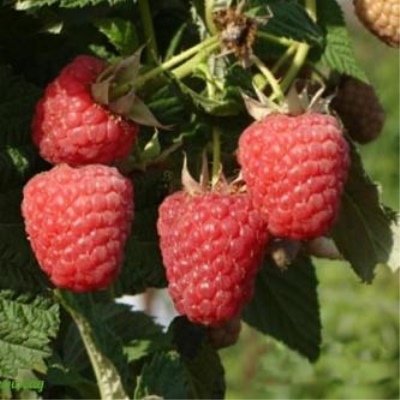
- Authors: All-Russian Institute of Selection and Technology of Horticulture and Nursery
- Berry color: red
- Taste: sweet and sour
- Ripening period: mid-late
- Berry weight, g: 3-6 g
- Yield: 2-3 kg per bush, 200-273 kg / ha
- Frost resistance: low-resistance
- Tasting assessment: 4,0
- Fruiting period: July
- Watering: moderate
For many people, raspberries are the most delicious berry crop. That is why it is so often found on the plots of gardeners from all over the world. Mirage is one of the most popular varieties of this crop.
Breeding history of the variety
Raspberry Mirage was bred at the All-Russian Institute of Selection and Technology of Horticulture and Nursery. Two Scottish varieties were taken for breeding: 707/75 and Large Dvoroda. So it was possible to derive a hybrid version, which was given the name K151. The raspberry got its current name in 1980.
Description of the variety
Raspberry Mirage has vigorous, medium-sized bushes. Medium spreading specimens grow up to 250 centimeters in height. Annual shoots have a dirty brown tint and a light waxy coating, no pubescence. Biennial shoots have a gray color, they are weakly geniculate and strongly thorny.
Mirage leaves can be either medium or small. Their color is green, classic. The foliage is corrugated, strongly curled, pubescent. The teeth are medium sharp. Thorns are located throughout the shoot. They are short, soft and straight. They are distinguished by their smallness and dark purple tone.
Ripening terms
Mirage berries are characterized by a medium-late ripening period. The fruiting period begins in mid-July and ends in late August.
Yield
The variety is distinguished by a high degree of yield: from one bush you can collect 2-3 kilograms of berries, and from one hectare - 200-273 centners. Mirage begins to bear fruit 2 years after planting.
Berries and their taste
The berries of the described variety are distinguished by an elongated and obtuse-conical shape. They are large and medium in size, weighing from 3 to 6 grams. There is no gloss and pubescence on the fruits. The red fruits are very dense, so they will tolerate transportation without any problems. Their taste is sweet and sour, and the aroma is pronounced. Ripe fruits are good for fresh consumption. They are also suitable for compotes, jams, freezing. Tasting taste assessment - 4 points.

Growing features
Mirage is grown in the same way as other raspberry varieties. However, it is worth noting that this strain is in dire need of a proper garter. The fan-shaped method is often used: two pillars are placed between the bushes, to which branches of two bushes are tied at different levels. And also quite often they practice growing on trellises.
Site selection and soil preparation
In one place, the Mirage can grow for about 9 years, then the location of the raspberry tree should be changed. It is necessary to choose sunny areas. Raspberries can be placed in partial shade, but this is an extreme option. Groundwater should be located no higher than 150 cm to the soil surface. The soil can be any, acidity - 5.6-6.5 pH. Before planting, the site is dug up 30 cm deep, fertilized with humus.


Pruning
It is carried out immediately after planting, shortening the shoots by 15-20 centimeters. Further sanitary pruning is carried out in the spring and autumn, removing the branches that have borne fruit and the specimens damaged by the cold.

Watering and feeding
Although Mirage loves water, watering should be moderate. In extreme heat, their number is increased, but the bush cannot be poured. The liquid should penetrate 80 cm into the ground. Watering can be combined with shallow loosening and mulching.
In general, raspberries of this variety do not need to be fertilized. But if there is a desire to get especially large fruits, then it is worth feeding the culture with organic matter and mineral fertilizers. Top dressing should be applied in the fall, after watering. Mirage responds well to feeding with wood ash.


Frost resistance and preparation for winter
Mirage is characterized by average resistance to cold, and therefore it should be helped to overwinter without loss. After harvesting, the shoots are pruned, foliage is removed. If the winter is snowy, then the shoots are simply bent to the ground. In regions with little snowy winters, plants are insulated with a thick layer of leaves or covering material.

Diseases and pests
The plant is quite resistant to pests and fungal diseases. But this variety can be sick with rust, root cancer, chlorosis. Of the pests, aphids and insects appear most often, which parasitize precisely on raspberries. Both diseases and pests are difficult to fight, so it is important to prevent their appearance by timely prevention.

Unfortunately, raspberries, like other plants, do not bypass various diseases and pests. Only armed with the knowledge and the necessary means for this, you can cope with such troubles. To help the plant, it is very important to be able to recognize the disease in time and begin timely treatment.
Reproduction
Mirage can be propagated in 3 ways:
division of an adult bush;
use of cuttings;
shoots.
The last method is the most popular. It is important to remember that the scions must be dug out together with the earthy clod when the ground is wet. The procedure, done in the spring, will allow you to get strong bushes by the fall.
Root cuttings are used if the variety has produced little growth. Roots located half a meter from the mother bush will do. In the fall, thick specimens will need to be dug up, cut into 20-centimeter cuttings and stored until spring. In spring, root cuttings are planted in the soil.








































































